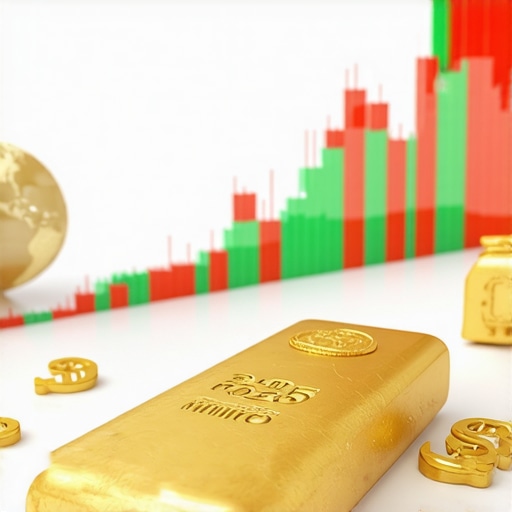Understanding Gold Demand Trends: What Investors Need to Know
Gold has long been considered a safe-haven asset, especially in times of economic uncertainty. As we analyze gold demand trends, it’s essential to understand the factors that influence these shifts and how they can impact investment decisions. Historical data reveals key insights into how various elements, such as global economic conditions, geopolitical tensions, and currency fluctuations, affect the demand for gold.
The Role of Economic Indicators in Gold Demand
One of the primary drivers of gold demand is economic indicators. Investors often turn to gold when they anticipate economic downturns or instability. For instance, during periods of high inflation or recession, gold tends to maintain its value or even appreciate, making it a popular choice for those looking to safeguard their wealth. Understanding the gold price forecasts can provide investors with insights into how these economic conditions might unfold.
Geopolitical Factors Affecting Gold Demand
Geopolitical tensions can also significantly influence gold demand. For example, conflicts, trade wars, or political instability often lead to increased buying of gold as a protective measure. The uncertainty surrounding these events tends to drive investors towards gold as a secure investment. Keeping track of key market analyses can help investors stay informed about potential geopolitical risks that may affect their investments.
The Impact of Central Bank Policies
Another critical factor to consider is the role of central banks in gold demand trends. Central banks around the world hold significant gold reserves, and their buying or selling actions can dramatically influence market dynamics. When central banks increase their gold purchases, it typically signals a lack of confidence in other assets, prompting individual investors to follow suit. Moreover, understanding how central bank policies impact gold prices can be a game-changer for investors navigating the gold market.
Consumer Demand and Cultural Influences
In addition to the macroeconomic factors, consumer demand plays a vital role in shaping gold demand trends. In many cultures, gold is not only a symbol of wealth but also an essential part of traditional ceremonies and celebrations. Countries like India and China have historically been significant consumers of gold, especially during festivals and wedding seasons. By examining the different types of gold investments, investors can gain insights into how cultural factors contribute to demand fluctuations.
As we delve deeper into the current landscape of gold demand trends, it’s crucial for investors to remain vigilant and informed. Understanding the various factors affecting gold prices can aid in making more strategic investment decisions. For instance, as we approach 2025, keeping an eye on upcoming market analysis reports will prove beneficial in anticipating shifts in demand and price movements.
Analyzing Gold Market Trends and Their Implications
As we dive deeper into the gold market, understanding gold demand trends becomes vital for making informed investment decisions. One way to gauge these trends is through market analysis, examining historical data and current events that impact gold prices. For example, the correlation between gold prices and inflation rates often provides insights into how investors can protect their wealth during economic downturns.
The Relationship Between Inflation and Gold Prices
Inflation is a significant factor affecting gold demand. When inflation rises, the purchasing power of currency declines, driving investors towards gold as a hedge. This relationship is crucial for investors aiming to preserve wealth. Moreover, monitoring gold price forecasts can offer additional clarity on potential market shifts.
Global Economic Factors Influencing Gold Demand
Various global economic factors also play a role in shaping gold demand. For instance, economic growth rates, employment statistics, and consumer confidence can impact how investors view gold as a safe haven. In periods of economic growth, demand for gold may decrease as investors seek higher returns in equities. Conversely, during economic uncertainty, gold often sees increased demand as investors flock to its perceived stability.
Technological Advances and Their Impact on Gold Investments
Technological developments in the mining and trading of gold can also influence market dynamics. Innovations that reduce production costs or improve extraction methods can change the supply landscape, affecting gold prices. Investors should keep an eye on different types of gold investments and how technology may affect their viability and return potential.
Understanding Gold Trading Techniques
To navigate the gold market effectively, investors must master various trading techniques. Familiarity with options like gold ETFs, futures, and physical gold investments can enhance an investor’s portfolio. For those looking to enhance their trading skills, exploring effective gold trading techniques is essential. These strategies not only help in maximizing returns but also in minimizing risks associated with market fluctuations.
Market Sentiment and Its Influence on Gold Demand
Market sentiment can significantly affect gold demand trends. Investor psychology often drives gold prices, with fear and uncertainty leading to increased buying. Keeping track of gold demand insights can help investors gauge sentiment and make timely decisions. Understanding how market sentiment shifts can provide a competitive edge in the ever-evolving gold landscape.
Looking Ahead: Gold Demand Trends in 2025
As we approach 2025, several factors will likely shape gold demand. Economic forecasts, geopolitical tensions, and changes in consumer behavior will all play a role. Investors should remain proactive in monitoring these trends and preparing their strategies accordingly. For instance, keeping an eye on 2025 gold price forecasts will be crucial in making informed investment decisions.
Furthermore, understanding how demand trends affect investments can help investors align their portfolios with future market dynamics. By staying informed and adaptable, investors can position themselves for success in the evolving gold market.
Exploring Investment Opportunities in Gold Mining Stocks
As investors consider their options in the gold market, one area gaining attention is gold mining stocks. These stocks can provide exposure to gold prices while offering potential for capital appreciation. Investing in companies that extract gold can be lucrative, especially if they employ efficient mining techniques and effective management strategies. Understanding the risks and rewards associated with gold mining stocks will equip investors to make informed decisions in this sector.
The Importance of Evaluating Mining Companies
Before investing in gold mining stocks, it’s crucial to evaluate the financial health and operational efficiency of the companies in question. Key metrics to consider include production costs, reserves, and historical performance. Additionally, staying updated on future gold price forecasts can help in predicting how these companies will fare in the changing market landscape.
Understanding the Role of Gold ETFs
Another investment vehicle worth exploring is gold exchange-traded funds (ETFs). Gold ETFs offer a cost-effective way to gain exposure to the gold market without the complexities of owning physical gold. These funds track the price of gold and allow investors to trade shares on stock exchanges. Familiarizing yourself with the best gold ETFs can enhance an investor’s portfolio and provide diversification benefits.
The Benefits of Physical Gold Investments
Despite the rise of digital investment options, many investors still prefer physical gold investments. Owning tangible gold, such as coins or bars, can provide peace of mind and serve as a hedge against inflation. Understanding the benefits of holding physical gold is essential for those looking to secure their assets in volatile markets.
Impact of Global Events on Gold Demand in 2025
As we look ahead to 2025, global events will likely impact gold demand significantly. Investors should keep an eye on geopolitical developments, global economic shifts, and environmental changes that could influence market dynamics. For instance, major elections, policy changes, and international relations can lead to fluctuations in gold prices, prompting investors to adjust their strategies accordingly.
The Influence of Central Bank Actions
Central banks play a pivotal role in shaping gold demand. Their policies regarding gold purchases can signal confidence in the economy or prompt investors to reassess their portfolios. Tracking central bank activities can offer valuable insights into future gold demand trends and price movements.
Technological Innovations in Gold Trading
Technological advancements are also influencing the gold market. Innovations in trading platforms, data analytics, and mining technology are changing how investors engage with gold. Staying informed about effective gold trading techniques can empower investors to leverage these technological shifts for enhanced investment strategies.
In conclusion, as we navigate the complexities of gold demand trends leading into 2025, understanding diverse investment options and staying informed about market dynamics will be crucial for success. By monitoring the factors discussed, investors can position themselves to capitalize on emerging opportunities in the evolving gold market.
Exploring the Future of Gold Demand Trends
As we look toward the future, understanding gold demand trends becomes increasingly vital for investors. Factors such as economic shifts, technological advancements, and market sentiment will significantly shape the landscape of gold investments. Staying informed about these elements will enable investors to make strategic decisions that align with emerging opportunities.
Investment Strategies for Gold in 2025
With the evolving market conditions, investors should consider diverse investment strategies tailored to the changing dynamics of gold demand. For instance, integrating long-term wealth strategies can help investors navigate through potential fluctuations in gold prices. Additionally, diversifying into gold mutual funds can provide a balanced approach to exposure while mitigating risks associated with volatility.
Technological Innovations Shaping Gold Investments
The impact of technology on the gold market cannot be overstated. Innovations in mining techniques and trading platforms are revolutionizing how investors access and engage with gold. For example, advancements in gold futures trading allow investors to hedge their investments more effectively. Staying abreast of these changes can provide a competitive edge in capitalizing on new investment opportunities.
Understanding Market Psychology and Gold Demand
Market psychology plays a crucial role in shaping gold demand. Investor sentiment can drive significant price movements, especially during periods of uncertainty. By monitoring gold demand insights, investors can gauge sentiment shifts and adapt their strategies accordingly. Understanding how fear and confidence influence buying patterns will aid in making timely investment decisions.
The Role of Global Events in Gold Demand
Global events, including political elections, economic policies, and environmental changes, will continue to impact gold demand. Investors should remain vigilant about upcoming trends and insights that could influence their portfolios. By keeping an eye on geopolitical developments and economic forecasts, investors can position themselves to respond proactively to market shifts.
Maximizing Returns with Informed Gold Investments
To maximize returns in gold investments, it’s essential to be well-informed about the current market landscape. This includes understanding factors like gold price forecasts and various gold investment vehicles available in the market. For those interested in trading techniques, mastering different approaches can enhance profitability and reduce associated risks.
Conclusion: Preparing for the Future of Gold Investment
In conclusion, as we approach 2025, the gold market will present a spectrum of opportunities for savvy investors. By understanding gold demand trends and remaining adaptable to changing circumstances, investors can cultivate a resilient investment strategy. Whether through gold stocks, ETFs, or physical gold, keeping informed and strategically aligned with market fluctuations will be key to achieving long-term success.
Frequently Asked Questions About Gold Demand Trends
What are the main factors driving gold demand?
Gold demand is primarily driven by economic indicators, geopolitical tensions, central bank policies, and consumer behavior. Economic downturns often lead to increased gold purchases as investors seek stability. Geopolitical events can also elevate demand due to uncertainty, while central banks influence the market through their gold holdings and purchases.
How does inflation affect gold prices?
Inflation typically leads to higher gold prices as the purchasing power of currency declines. Investors turn to gold as a hedge against inflation, driving up demand. Monitoring inflation trends is crucial for predicting gold market movements.
Why is gold considered a safe-haven asset?
Gold is considered a safe-haven asset because it tends to retain its value during economic downturns, geopolitical instability, and financial crises. Investors often gravitate towards gold to safeguard their wealth, leading to increased demand during turbulent times.
What role do central banks play in gold demand?
Central banks are significant players in the gold market, holding substantial reserves. Their buying or selling activities can influence global gold prices. When central banks increase their gold purchases, it often signals a lack of confidence in other currencies or assets, prompting individual investors to follow suit.
How can I invest in gold?
Investing in gold can be done through various avenues, including physical gold (coins, bars), gold exchange-traded funds (ETFs), gold mining stocks, and gold mutual funds. Each option has its advantages and risks, so it’s essential to consider your investment goals before choosing.
What are gold ETFs, and how do they work?
Gold exchange-traded funds (ETFs) are investment funds that track the price of gold and are traded on stock exchanges. They provide a way for investors to gain exposure to gold without owning physical gold. Gold ETFs are typically less costly to manage than physical gold investments.
How do global events impact gold demand?
Global events such as political elections, economic policies, and environmental changes can significantly influence gold demand. Investors should stay informed about such events, as they can lead to fluctuations in gold prices and impact investment strategies.
Why is it important to understand gold demand trends?
Understanding gold demand trends is crucial for investors aiming to make informed decisions in the gold market. By analyzing economic indicators, geopolitical factors, and market sentiment, investors can identify potential opportunities and align their investment strategies accordingly.
What are some key resources for learning about gold investments?
For in-depth knowledge about gold investments, consider resources such as the World Gold Council, Kitco, and reputable financial news websites. Books on gold investment strategies and market analyses can also provide valuable insights.
Authority Resources for Gold Investment Insights
To further enhance your understanding of gold demand trends and investment strategies, consider exploring the following trusted resources:
- World Gold Council – A leading authority on gold, providing comprehensive market analysis, demand trends, and investment insights.
- Kitco – A reputable source for real-time gold prices, market news, and expert commentary on gold investments.
- Investopedia – Offers articles and guides on gold investment strategies, market dynamics, and economic factors influencing gold prices.
- Forbes – Provides financial news and analysis, including insights on gold market trends and investment opportunities.
- Bloomberg Commodities – A trusted platform for commodities market data, including gold, with news and analysis tailored for investors.
By utilizing these resources, investors can stay informed and make strategic decisions that align with their financial goals.
Conclusion: Navigating Gold Demand Trends for Investment Success
As we approach 2025, understanding gold demand trends is essential for investors looking to capitalize on emerging opportunities in the market. By staying informed about economic indicators, geopolitical factors, and consumer behavior, investors can make strategic decisions that align with market dynamics. Whether through gold stocks, ETFs, or physical gold, continuous learning and adaptability will be key to achieving long-term success in the evolving gold landscape.










This comprehensive overview on gold demand trends really highlights how interconnected geopolitical and economic factors are with market movements. I’ve personally noticed that during times of global uncertainty, gold often outperforms other assets as a safe haven, especially when central banks increase their reserves. Interestingly, I wonder how technological advances, like blockchain and digital gold, will influence these traditional demand drivers in the future. Have others observed any early signs of digital assets beginning to affect physical gold’s demand? I believe staying updated on both macroeconomic factors and emerging technologies will be crucial for making informed investment decisions going forward.